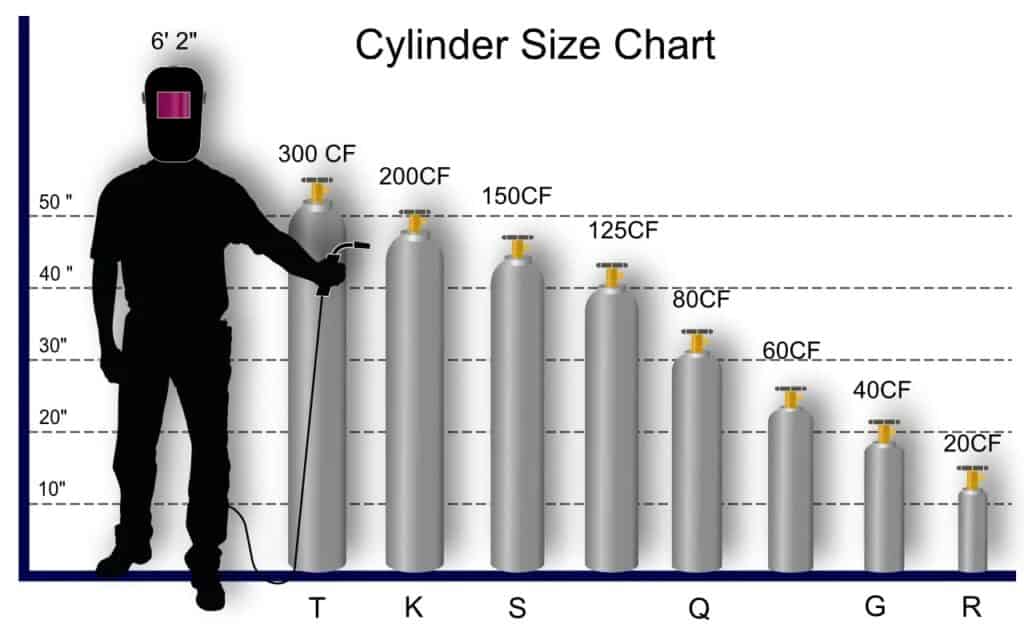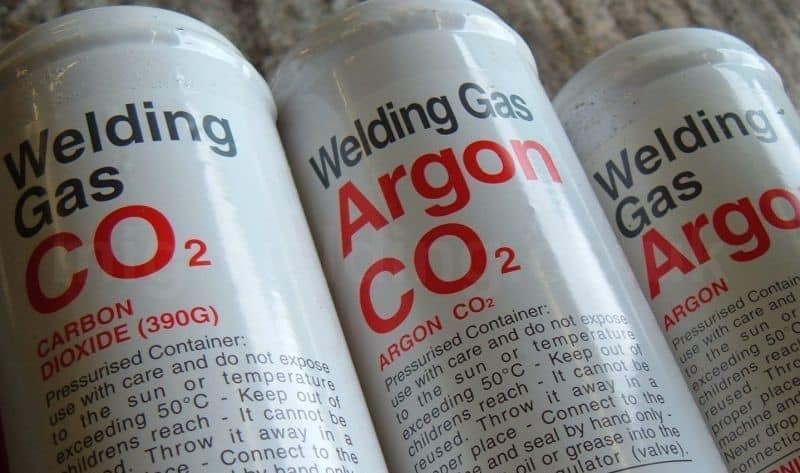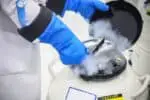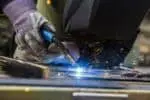Taking up a welding project for the very first time, for some work around the house means you will not know how much gas you will need for the job to be completed successfully, nor would you know what size gas cylinder you should use for your welding project.
Since here we are specifically talking about MIG welding, let me enlighten you with the different size gas cylinders that are available for you to purchase online or from the market.
 As a hobby welder or a homeowner, you have three sizes of tanks or cylinders – 40, 80, and 125 cubic feet (cf). Out of which you should go for the 125 cf tank, which is the largest and the more expensive one out of the lot.
As a hobby welder or a homeowner, you have three sizes of tanks or cylinders – 40, 80, and 125 cubic feet (cf). Out of which you should go for the 125 cf tank, which is the largest and the more expensive one out of the lot.
But if you have the spending and space capacity in your workspace, then that is the best option. Refilling it costs much lesser comparatively, and it will last you longer. Again, this will mainly depend on how big or small your welding work is going to be.
In this article, I have covered most of the basic information on gas cylinders that will come in handy for you before you make a purchase blindly for MIG welding.
What are the different types of gas used for MIG welding?
There are various types of gases available that can be used for MIG welding, which you should know of to be a better judge of things when attempting MIG welding.
1. Argon and Carbon Dioxide mixture
The mixture of Argon and CO2 gas is used quite frequently for MIG welding. The ratio is mostly 75% Argon 25% CO2, which is very common as most welding jobs can be easily handled with this gas.
The smooth weld with the least amount of spatter can be achieved with the Argon content, and CO2 provides you with the required perforation when welding.
When you work with these gases, you must work in a place with adequate ventilation, because oxygen can be extracted by them, which can be highly dangerous. This mix works best as a shielding gas for welding work with stainless steel and carbon.
2. Argon
For getting the cleanest welding results, using Argon gas is your best bet for MIG welding. You will get really good quality welds when welding non-ferrous metals like aluminum, magnesium, or titanium if you use Argon.
However, it is specifically the best gas to use if you are working only with aluminum. It is one of the most commonly used gases for both MIG and TIG welding. Studies show that it is the 3rd most copious gas on earth that is a part of the noble gases group.
Meaning, even in the most extreme conditions this gas does not react with anything and is so versatile that it can be used for numerous applications. Argon plays the role of shielding gas, as well as a purging gas in welding applications.
It is, however, an expensive gas compared to CO2, hence, you will mostly find people using a mixture of the two. And even though argon gives you a steady arc, it does not penetrate very deep.
3. CO2 or Carbon Dioxide
CO2 is a semi-inert gas that is used by people for MIG welding quite commonly because it is very cost-effective. Apart from it being the cheapest option, it also provides you with deep metal penetration and can work wonders without being combined with other inert gases.
However, the biggest problem with CO2 is that it results in a lot of spatters due to its harsher arcs. This leads to having to clean up around the welded area once welding is done. Even though it does not react to chemical change, compared to inert gases its resistance is quite less.
It does act as a great shielding gas which helps prevent the weld from getting contaminated and works well with ferrous metals like mild steel.
See also: What Are the Benefits of Using CO2 in MIG Weld?
4. Helium
Helium is also a noble or inert gas that can be used for MIG welding. It is a more expensive option compared to Argon, but its thermal conductivity is superior, and the ionization probability is much higher. Due to this more heat can be achieved with Helium.
However, it does have a lower density with the possibility to procure higher flow rates when we compare it to Argon. It is the perfect choice for welding thick, non-ferrous metals, and stainless steel.
This gas gives you a deep and wide penetration into the metal. It is considered to be the most popular shielding gas to be used with stainless steel and aluminum.
Since Helium is expensive, it is often mixed with CO2 to reduce cost without compromising on the weld quality. It can be even mixed with only argon but then its usage is limited to only aluminum and copper.
One important thing to keep in mind is that helium uses more power than other gases, and you have to be more cautious while using it to steer clear of exhaustion and overheating. Hence, it is more commonly found being used in an industrial surroundings.
5. Nitrogen
If you are working with stainless steel then you can use a mixture of Nitrogen and Argon gas. Otherwise, it is not a commonly used gas. You can expect good steady arc and deep weld penetration from Nitrogen.
In the case of plasma cutting and laser welding, then Nitrogen acts as a shielding gas. One of the main advantages of using Nitrogen is that it helps prevent oxides from forming, which can make the welds weak by contaminating them.
However, please do not use it if you plan to work with carbon steel, even if it does not react at room temperature.
See also: Can Nitrogen be Used for MIG Welding?
6. Hydrogen
Hydrogen is a gas that can be used when working with stainless steel but it has to be mixed with Argon. It also acts as a popular shielding gas and works great on metals when high temperature is required. Jewelry making process does involve working with Hydrogen.
Which is the best gas for MIG welding?
For MIG welding a mixture of argon and CO2 will be the best option. The ratio should be 75% argon 25% CO2 to get the best weld quality.
The reason is that it can be used to weld most types of metal, and is your most cost-effective choice due to CO2 being the cheapest gas there is for welding purposes.
You can even blend the two with the ratio being 80% argon 20% CO2. It acts as a great shielding gas with less spatter so you do not have much to clean up post welding.
How to determine the right size cylinder for welding?
It is not entirely difficult to decide on the right size cylinder for welding. I have simplified it for you with the below points.
1.) You need to see for yourself how often can you afford to take out time to refill the cylinder. Regardless of the refilling method you use, which could be either through a dealer or a scheduled service.
2.) Getting a portable size is always a smart thing to do because then traveling to different work sites will not be much of a hassle and there are fewer chances of getting injured by accidentally dropping the cylinder.
3.) You need to factor in the mode of transporting the gas cylinder, as it needs to be well ventilated. The gasses also consume a lot of the oxygen that you will be breathing too.
4.) As a hobbyist welder, you perhaps do not need a cylinder that is used by a professional welder, who will probably use a bigger-sized cylinder for his job.
5.) Check the convenience of getting the cylinder exchanged when the need arises because not all gas cylinder dealers will provide this service of exchanging a full one for an empty one.
How long does the gas last in the cylinder?
Generally, this will depend on the kind of work you are doing, which again depends on the flow rate that is anywhere between 10 – 40 cubic feet per hour.
The popular equation that is widely used by welders is: Gas welding time (hours) = [cylinder volume (cf) / [flow rate (cfh)]
Even these calculations may not give you the most accurate answer because the changes in temperature and the number of times you have stopped and started can influence the calculations.
More so, if your cylinders have pre/post flow settings on. You need to keep a check on the regulator and constantly adjust it according to the temperature changes as it will affect your flow rate directly.
We would advise you to always set the gas regulator back to zero when are done using it for the day.
How do we know the amount of gas left in the cylinder?
If you are using Argon and Argon+CO2 mixture gas cylinders, there is a pressure gauge on the regulator which will give an estimate on the amount of gas left in the tank.
However, this is not the case with pure CO2 cylinders because there is a sudden drop in the pressure towards the end, so the pressure gauge is not so reliable.
In such cases, you will need to weigh the cylinder. All you need to remember is to always adjust your flow rate because the pressure changes as and when the temperature changes.
What are the safety guidelines while using gas cylinder for welding?
It goes without saying that you need to follow some safety measures when using gas for welding because it can be very dangerous.
1.) You need to make sure that the cylinder is in proper working condition. Which means that the piping, valves, lines, and manifolds have no defects and are absolutely secure.
2.) Wear proper protective work gear which should include safety glass, safety boots, and gloves.
3.) You must store or keep the cylinder away at a minimum distance of 20 feet from all inflammable materials, which includes electrical circuits, open flames, oil, grease, and contaminated things.
4.) When you are not using the cylinder, keep the valves and dust plug/pressure cap properly closed and secured.
5.) Every time you have to or need to move the gas cylinders, make sure to use a handcart that is designed specifically for this purpose.
6.) You must regularly clean the cylinder and valves.
7.) You should never lift the gas cylinder using its valve cap, because God forbid it is loose, in which case there is a possibility of you dropping the cylinder and damaging it in the process.
8.) The cylinder should be stored in an upright position on a surface that is uniform and not uneven, as this will prevent it from toppling over.
9.) Segregate the full cylinders from the empty ones in separate areas, and keep the full ones strapped or chained.
Wrapping up
Now that you have the basic idea on how these gas cylinders work when using it for MIG welding, I hope you enjoy your welding project, while following all the safety measures needed. Happy welding!








